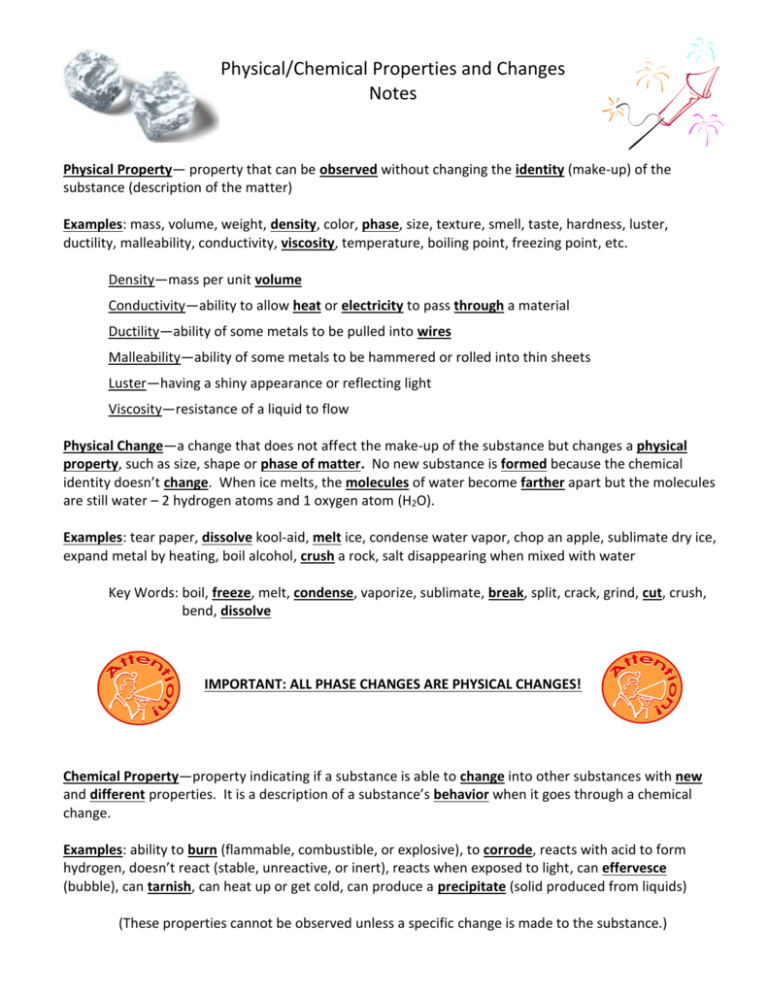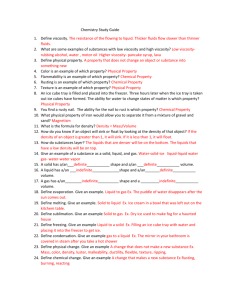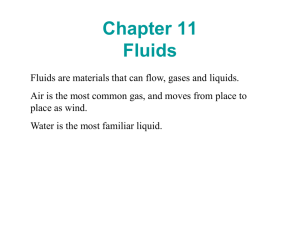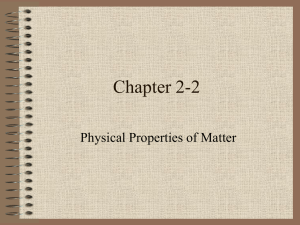Physical/Chemical Properties and Changes Notes Physical Property
advertisement

Physical/Chemical Properties and Changes Notes Physical Property— property that can be observed without changing the identity (make-up) of the substance (description of the matter) Examples: mass, volume, weight, density, color, phase, size, texture, smell, taste, hardness, luster, ductility, malleability, conductivity, viscosity, temperature, boiling point, freezing point, etc. Density—mass per unit volume Conductivity—ability to allow heat or electricity to pass through a material Ductility—ability of some metals to be pulled into wires Malleability—ability of some metals to be hammered or rolled into thin sheets Luster—having a shiny appearance or reflecting light Viscosity—resistance of a liquid to flow Physical Change—a change that does not affect the make-up of the substance but changes a physical property, such as size, shape or phase of matter. No new substance is formed because the chemical identity doesn’t change. When ice melts, the molecules of water become farther apart but the molecules are still water – 2 hydrogen atoms and 1 oxygen atom (H2O). Examples: tear paper, dissolve kool-aid, melt ice, condense water vapor, chop an apple, sublimate dry ice, expand metal by heating, boil alcohol, crush a rock, salt disappearing when mixed with water Key Words: boil, freeze, melt, condense, vaporize, sublimate, break, split, crack, grind, cut, crush, bend, dissolve IMPORTANT: ALL PHASE CHANGES ARE PHYSICAL CHANGES! Chemical Property—property indicating if a substance is able to change into other substances with new and different properties. It is a description of a substance’s behavior when it goes through a chemical change. Examples: ability to burn (flammable, combustible, or explosive), to corrode, reacts with acid to form hydrogen, doesn’t react (stable, unreactive, or inert), reacts when exposed to light, can effervesce (bubble), can tarnish, can heat up or get cold, can produce a precipitate (solid produced from liquids) (These properties cannot be observed unless a specific change is made to the substance.) Chemical Change—a change that produces a new substance with different properties. (Atoms are rearranged.) When a substance goes through a chemical change, some of its physical properties change but the difference it that the changed physical properties are of a new substance. For example, when sugar is heated enough, it changes from a sweet, white crystal to a black substance and a clear liquid. Its physical properties have changed but that is because it is a new substance. Chemical changes are taking place in our bodies and all around us all the time. Common Examples: 1. Combustion—chemical change in which a substance combines rapidly with oxygen. Examples: paper burning, gasoline burning, hydrogen burning, gun powder exploding 2. Corrosion—chemical change in which a metal is gradually changed into a new substance. Examples: iron rusting, silver tarnishing, copper corroding 3. Cooking Food—involves many chemical reactions. Examples: baking a cake, cooking an egg 4. Life Processes—involves the many chemical changes that occur in living organisms. Examples: digestion, respiration, photosynthesis Key Words: rot, rust, decompose, ferment, grow, decay, corrode, bake, cook, burn Evidence of Chemical Change Some chemical changes, like iron rusting, take place slowly and clues may not be observed. Identifying observed changes as physical or chemical can be tricky because in both cases there are changes in physical appearance. In general, physical changes are noted for the ease with which they can be reversed. You need only restore the original conditions and the substance changes back to its original form: Freeze water to become ice. Frozen ice melts upon warming and turns back into water. The following are common clues that a chemical change has occurred. 1. Gas is produced—this is usually indicated by bubbles. Bubbles don’t always mean a gas is being produced (such as air bubbles bubble when something boils). 2. Color or odor change—when a different color or odor appears suddenly, this usually means a new substance with new properties has formed. 3. Solid formed from 2 liquids—this is called a precipitate. If 2 liquids are combined and a solid substance suddenly appears that means that a new substance has been formed. 4. Heat released or absorbed—if a substance becomes warmer in temperature even though no heat is being added that is a clue that a chemical change is occurring. Substances can also get lower in temperature due to a chemical change. 5. Light produced—sometimes during a chemical change light is given off.











